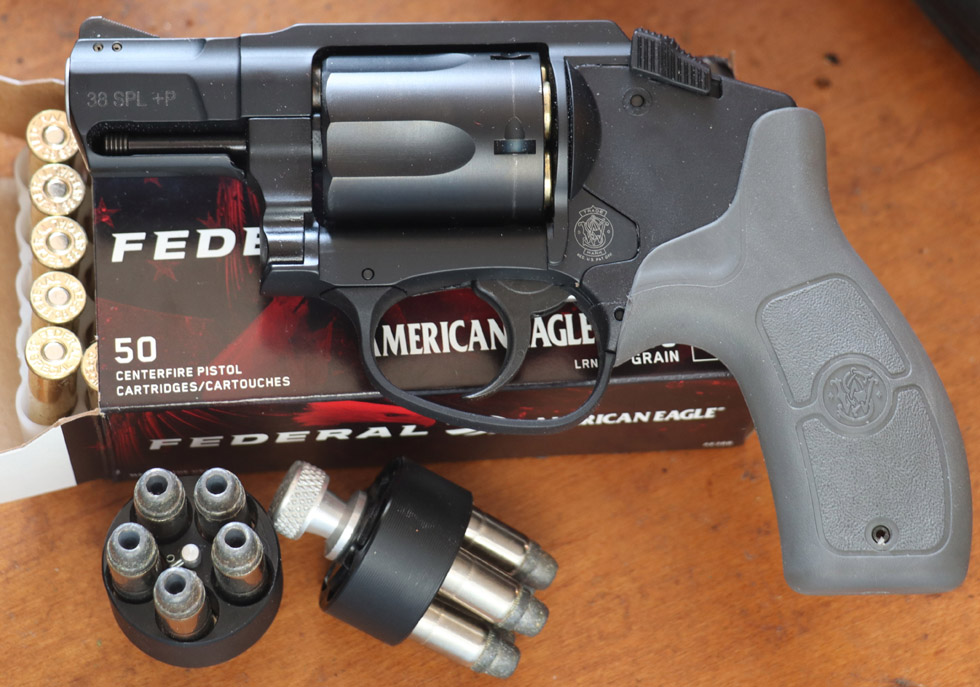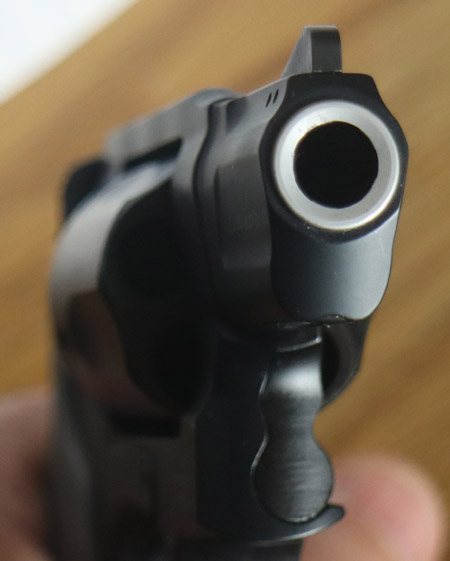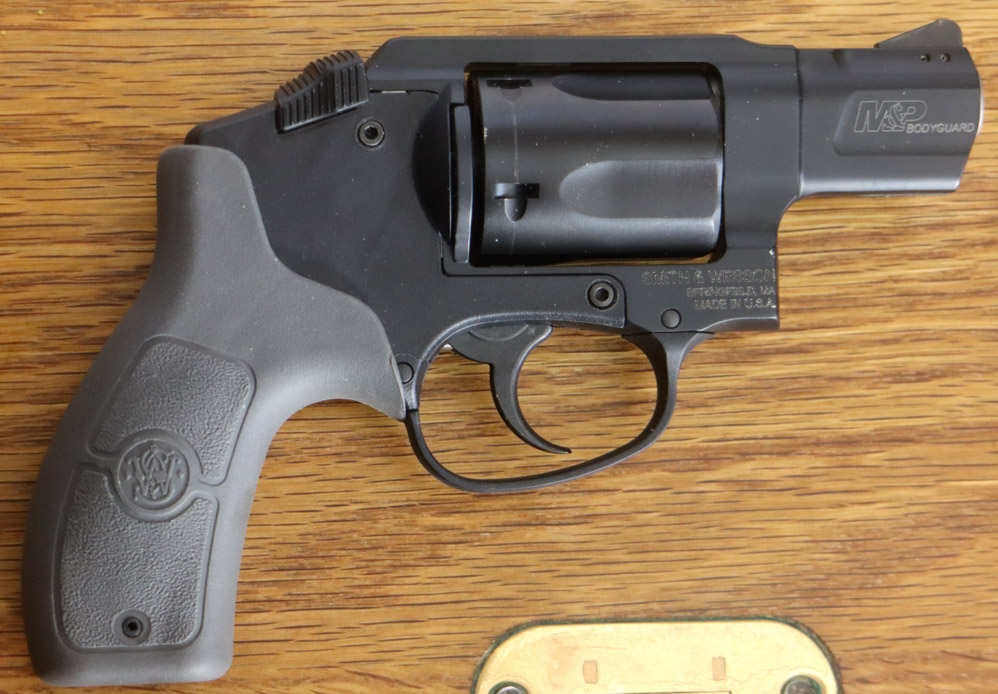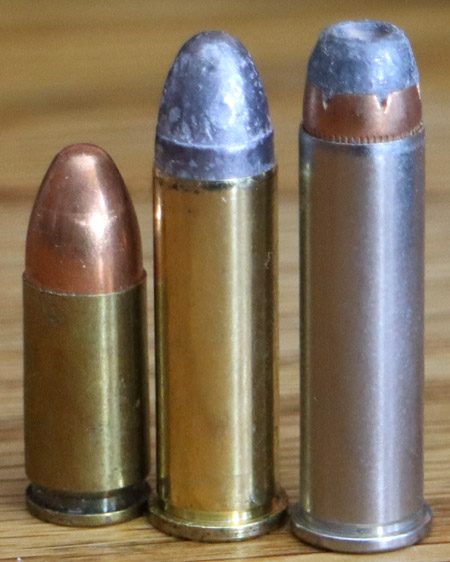
S&W Bodyguard 38
| Dimensions | Barrel Length | Weight | Caliber | Action Type | Magazine Capacity |
| 6.6" x 4.4" x 1.36 |
1.875" |
14.2 oz. |
.38 Special |
DAO Revolver |
5 |
Any firearm will end up being a compromise, between firepower, stopping power, safety, accuracy, concealment, and ease of use. Cost can also be a factor. With this model, S&W has decided to make all of the compromises in the direction of ease of use and concealability. Yet they haven't completely abandoned the idea of stopping power. There are smaller, less powerful firearms, that fire fewer shots. In the Bodyguard, S&W has made reasonable compromises. The cylinder holds five rounds of 38 special, a reasonable capacity in a relatively good stopping power cartridge. The gun is very small and very light, which does not help with accuracy or recoil management, but does make it easy to conceal and carry. The sub two inch barrel is along the same line of thought. The gun sells for a low $449, as of this writing.
Much of this design philosophy is based upon the intended user and most likely use scenario. For the person who is casually armed, or who carries this gun as a back up to a primary arm, it follows studies that suggest most defensive encounters with firearms take place within a few feet and are settled within a few rounds. Think of a fist fight, with the first person to land a punch being the winner.
For this type of scenario, small sights are fine, as is a short barrel. The most questionable feature of the gun is its double action only trigger. A double action trigger has a longer heavier pull than a single action, but single action needs to be cocked for every shot. So a single action trigger can enhance accuracy and precision, yet within a few yards, with small sights and a short barrel, such accuracy is not needed. Again we see the deign philosophy as tending towards speed, simplicity, and ease of carry, concealment, and presentation. This gun weighs less than a pound, and can be carried all day, without notice.
 I own one. It is my most common casual carry gun, having
replaced my well liked M649. , for
all the reasons mentioned above. I generally have it in an
IWB holster on my right hip, with a pair of speed loaders in
my left pocket, when weather and clothing permit. This gun
will also fit nicely, for summer wear, in a pocket holster,
or even an ankle holster. People who are not familiar with
them don't always realize just how thin and small a five
shot revolver can be. The frame is less than 3/4" in width,
with the cylinder coming in at 1.3" for the inch and a half
of its length. This thing will fit just about anywhere a 25
or 380 auto will fit, but it will have far more power.
I own one. It is my most common casual carry gun, having
replaced my well liked M649. , for
all the reasons mentioned above. I generally have it in an
IWB holster on my right hip, with a pair of speed loaders in
my left pocket, when weather and clothing permit. This gun
will also fit nicely, for summer wear, in a pocket holster,
or even an ankle holster. People who are not familiar with
them don't always realize just how thin and small a five
shot revolver can be. The frame is less than 3/4" in width,
with the cylinder coming in at 1.3" for the inch and a half
of its length. This thing will fit just about anywhere a 25
or 380 auto will fit, but it will have far more power. Once the small size is gotten used to, the first thing one notices about this gun is just how light it is. It feels like a toy. Those familiar with revolvers will notice that there seems to be no cylinder latch. It takes a bit of practice to get used to the cylinder latch being on the top rear of the frame, rather than the side, as has traditionally been the case. The latch sits where a revolver might usually be expected to locate the hammer spur for cocking. To release the cylinder, the release must be pushed forward.
 Semi auto pistols, particularly of the wonder nine variety
with polymer frames, dual column magazines, and striker
fired actions, have become so dominant that I always feel a
bit defensive when writing about a revolver I like. What is
it about the venerable revolver? Revolvers have been around,
in one form or another, for several hundred years, if you
count early developments like the Puckle Gun. The
first recognizable revolver, by today's standards, came
along in 1836, and what we would consider to be the modern
DA revolver was developed around the turn of the century.
This is a long run, by any account, and warnings about the
demise of the revolver have been sounded for a hundred years
or more. Yet the revolver remains, and even continues to be
developed.
Semi auto pistols, particularly of the wonder nine variety
with polymer frames, dual column magazines, and striker
fired actions, have become so dominant that I always feel a
bit defensive when writing about a revolver I like. What is
it about the venerable revolver? Revolvers have been around,
in one form or another, for several hundred years, if you
count early developments like the Puckle Gun. The
first recognizable revolver, by today's standards, came
along in 1836, and what we would consider to be the modern
DA revolver was developed around the turn of the century.
This is a long run, by any account, and warnings about the
demise of the revolver have been sounded for a hundred years
or more. Yet the revolver remains, and even continues to be
developed.One of the more recent ideas in revolver developments, is the use of polymers. This follows on the heels of the polymer framed semi automatic, that has been with us for several decades now, and have come to dominate the market.
There are limits to the strength even of modern polymers and alloys. In this case, we have a steel cylinder, and a steel barrel insert into the barrel portion of the frame. These are the areas subject to the most stress. It is pretty easy to tell, as shown in the photos, where the polymer and alloy portions of the frame separate. The internal lock-work is nothing like that of the old J frame. It uses a coil spring, and has a small, lever-like, hammer.
The gun has a nice look, With a slight radius on the barrel shroud and ejector shroud. and I really like the dark sheen of the finish.It is a very neat looking little gun. On the other hand, the grey plastic grip is a bit tacky, and the plastic cylinder release takes some getting used to, due to its location, and to the somewhat vague feel of the release itself, with a considerable amount of play. There is no real stop or indication when the release is all the way forward, and not much of a return when the cylinder locks back up. The cylinder also does not readily snap back into the frame if the release does not remain fully forward. As a whole, I do not care for the cylinder release system at all. A more traditional cylinder lock is not used due to the two piece frame, and the non standard internal lock-work.
How it shoots
Please note that
the following is my subjective evaluation. Perceptions vary,
and not all guns are meant to be hundred yard tack drivers.
This is certainly no tack driver. While this gun a a
pleasure to carry, it is not as enjoyable to shoot. None of
this is a surprise, but it bears mention. As stated above,
the compromises and decisions made in the design of this gun
were all in the direction of ease of use, and ease of carry.
I am by no means a competitive shooter, but I am reasonably skilled and hit what I aim at. With this gun, at five yards, I am able to get all the rounds on paper, but not always on the target, much less in the bulls-eye. Beyond ten or twenty yards, I would not feel confidant with this gun. There are several reasons for this, all alluded to above. It is the combination of light weight, double action only trigger, small sights, and short barrel radius that conspire to throw off my aim. During the same range session, I also shot my new Ruger SP101, which is also a 38 special snub nose. I was able to get all my shots into the bulls-eye with the Ruger, even as they were all over the target with this Bodyguard 38.
From the above, it may be assumed that I do not like or recommend this gun, but that is not true. I own and regularly carry one, but I am not blind to its faults, or its virtues. Within its area of specialization, this is a very good gun, but like any specialized piece of gear, it does one thing, and only one thing, very well. It must then be judged by its primary purpose.
This is not a gun to bring to a competition. It is not a gun to plink tin cans. It is not really a great gun for those who must go armed, such as police, security, or military. It is not a service or recreational gun. So what is it? This is a gun for deep concealment, or very casual carry. It is, to borrow an old term, a Belly Gun.
Belly Gun
This revolver hearkens back to the old and disreputable
concept of the Belly Gun. For those unfamiliar with the
term, a Belly Gun is a last ditch firearm to be used in
very close quarters where speed is everything. The term
derives not from the place the gun is carried, but from
the way in which the gun is used. A belly gun is used
when adversaries have closed to make direct physical
contact. At this point, the gun is used like a lead
fist, stuck into the belly of the opponent and fired.
The whole point of such a weapon is to get the lead out
as quickly as possible.
Things I hate about this gun
Things I hate about this gun
- The sights are poor
- The gun is DA only and can not be cocked
- The gun only holds five rounds
- The gun is slow and cumbersome to reload
- Its short barrel reduces muzzle velocity and decreases
accuracy.
- If you take the time to aim, you are dead
- If you take the time to cock, you are dead
- If you need more than a couple rounds, you are dead
- If you need to reload, you are dead
- The short barrel makes it faster to get into action.
If you are not first into action, you are dead.

Why the 38?
 What is it about the 38 Special? This round was developed
over a century ago, back in the days of black powder. Its
original load was of 21 grains of black power under a 158
grain lead slug. At the time of its introduction, it was a
cutting edge cartridge, meant for use in the newly developed
cutting edge swing out double action revolvers that
dominated law enforcement for most of the last century.
What is it about the 38 Special? This round was developed
over a century ago, back in the days of black powder. Its
original load was of 21 grains of black power under a 158
grain lead slug. At the time of its introduction, it was a
cutting edge cartridge, meant for use in the newly developed
cutting edge swing out double action revolvers that
dominated law enforcement for most of the last century. Today, less than 5 grains of modern powder will do the same job as the original 21 rains of black powder, so the case really is much longer than it needs to be for modern smokeless powders. This realization was what inspired development of the 357 Magnum. Modern powders and metals are also the reason the case of the ballistically very similar 9mm is so much shorter.
For decades, the combination of 38 Special in a swing out double action revolver was THE way for the modern police officer or military man, not to mention armed citizen, to be armed. As things got uglier, law enforcement started to go with Plus P rounds, then the 357 Magnum. Eventually, law enforcement largely abandoned the revolver altogether, and went with high capacity semi automatics on 9mm. Though loads vary, in general, the 9mm fires a somewhat lighter bullet at a slightly higher velocity.
The demise of the 38 has been predicted for decades, since the advent of the Wonder Nine style of semi auto pistol, and their large scale adoption by law enforcement.Yet this has failed to occur. Though the 38 no longer dominates the field as it once did, it still has a place, particularly for the casually armed civilian.
One big advantage to this cartridge, when compared to the popular 9mm, is its chambering in revolvers, particularly small light revolvers. This may not seem like an advantage at first look, when you consider the many high capacity revolvers out there with their many safety and sighting features, but there are advantaged to revolvers, even today.
Auto-loading handguns can be complex devices. I have had semi automatic handguns jam, misfire, or fail to feed. I have had issues with safeties, particularly grip safeties and magazine safeties. I have heard of shooters, under pressure, accidentally hitting the magazine release and ejecting loaded magazines from their guns. Such things do not happen with revolvers.
There are some revolvers that have been designed to fire the 9mm, but these tend to use either a loading device like a half moon of full moon clip, or have rather complex ejector systems to adapt the revolver to the rimless design of the 9mm cartridge. easier to simple chamber for the 38.
Another option to consider would be the 357 Magnum, which is used in many modern revolvers. The 357 was developed in the thirties to take full advantage of the newer metals and powders then available. It is slightly longer than the 38 Special, but this is only to prevent chambering in older guns. It is possible to load a 38 special to the same pressures, velocities, and energies as a 357. For a small gun with a 2" barrel, the 357 is unsuitable. In addition to the increase in recoil, much of the velocity of the 357 requires a slower powder and longer barrel, so the cartridge is just wasted in the short barreled guns.
A compromise between 38 and 357 is somewhat realized in the loading of the .38 +P round. Though not precisely defined, in general a +P round has an extra 10% energy when compared to a standard round.
The gun industry goes through phases, like any consumer industry, by following trends. There was the magnum trend, then the race to see who could produce a gun with the most safety features, or the highest capacity magazine. Then there were the gadgets, the lasers, the red dots, and the holosights. Today it is all about the new marked for CCW.
With this revolver, we have, in some sense, come full circle.
https://gunsmagazine.com/guns/belly-guns/?fbclid=IwAR0nvPeeWKgjVTUjh7-JnjmV3oeKVKvG-mtyqWVI9VtvlpsZloXQzN1qKGE